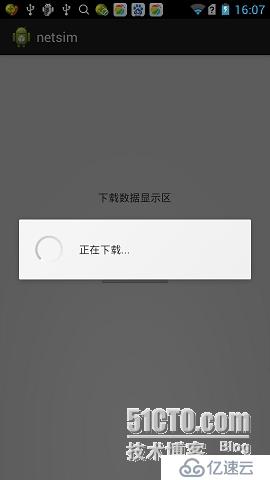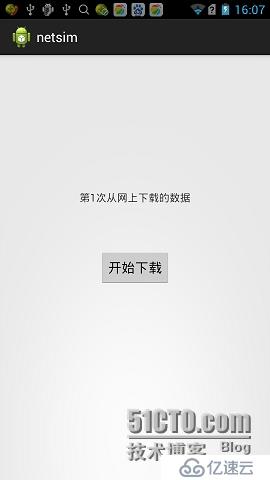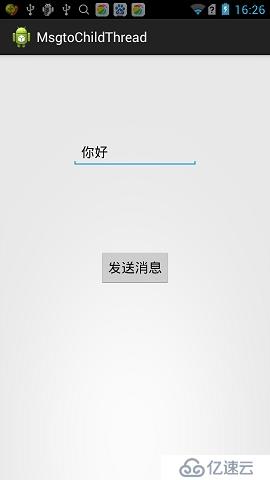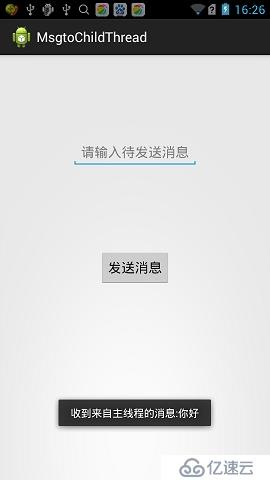жӮЁеҘҪпјҢзҷ»еҪ•еҗҺжүҚиғҪдёӢи®ўеҚ•е“ҰпјҒ
Androidзҡ„UIж“ҚдҪңдёҚжҳҜзәҝзЁӢе®үе…Ёзҡ„(еҮәдәҺжҸҗй«ҳжҖ§иғҪиҖғиҷ‘пјҢйҒҝе…Қе®һзҺ°еӨҡзәҝзЁӢеҗҢжӯҘзӯүжңәеҲ¶жүҖеј•е…Ҙзҡ„延时)пјҢиӢҘеӨҡдёӘзәҝзЁӢеҗҢж—¶еҜ№UIе…ғзҙ иҝӣиЎҢж“ҚдҪңпјҢеҸҜиғҪеҜјиҮҙзәҝзЁӢе®үе…Ёй—®йўҳгҖӮеӣ жӯӨпјҢAndroidдёӯеҒҡдәҶдёҘж јзҡ„规е®ҡпјҡеҸӘжңүUIдё»зәҝзЁӢжүҚиғҪеҜ№UIиҝӣиЎҢи®ҫзҪ®дёҺж“ҚдҪңгҖӮ
еңЁе®һйҷ…зј–зЁӢдёӯпјҢдёәдәҶйҒҝе…ҚUIз•Ңйқўй•ҝж—¶й—ҙеҫ—дёҚеҲ°е“Қеә”иҖҢеҜјиҮҙзҡ„ANR(Application Not Responding)ејӮеёёпјҢйҖҡеёёе°ҶзҪ‘з»ңи®ҝй—®гҖҒеӨҚжқӮиҝҗз®—зӯүдёҖдәӣиҖ—ж—¶зҡ„ж“ҚдҪңиў«ж”ҫеңЁеӯҗзәҝзЁӢдёӯжү§иЎҢгҖӮиҝҷе°ұйңҖиҰҒеӯҗзәҝзЁӢеңЁиҝҗиЎҢе®ҢжҜ•еҗҺе°Ҷз»“жһңиҝ”еӣһеҲ°дё»зәҝзЁӢ并йҖҡиҝҮUIиҝӣиЎҢжҳҫзӨәгҖӮеңЁAndroidдёӯпјҢжҳҜйҖҡиҝҮHandler+Loop+MessageQueueе®һзҺ°зәҝзЁӢй—ҙйҖҡдҝЎзҡ„гҖӮ
е…ҲзңӢдёӨдёӘе®һдҫӢпјҡ
е®һдҫӢ1пјҡжЁЎжӢҹйҖҡиҝҮзҪ‘з»ңдёӢиҪҪж•°жҚ®е№¶иҝ”еӣһUIжҳҫзӨәгҖӮ
ж“ҚдҪңиҝҮзЁӢдёәпјҡ1.UIзәҝзЁӢиҺ·еҫ—з”ЁжҲ·иҜ·жұӮгҖӮ2.еҗҜеҠЁеӯҗзәҝзЁӢе®ҢжҲҗзҪ‘з»ңж•°жҚ®дёӢиҪҪ(зҪ‘з»ңдёӢиҪҪиҝҮзЁӢйҖҡиҝҮејәеҲ¶еӯҗзәҝзЁӢдј‘зң иӢҘе№Із§’жқҘжЁЎжӢҹ)гҖӮ3.еӯҗзәҝзЁӢе°ҶдёӢиҪҪзҡ„ж•°жҚ®иҝ”еӣһUIзәҝзЁӢ并жҳҫзӨәгҖӮ
дё»иҰҒд»Јз ҒеҰӮдёӢпјҡ
public class MainActivity extends ActionBarActivity {
private Button mButton;
private TextView mTextView;
private Handler mHandler;
private Thread mNetAccessThread;
private ProgressDialog mProgressDialog;
private int mDownloadCount = 0;
@Override
protected void onCreate(Bundle savedInstanceState) {
super.onCreate(savedInstanceState);
setContentView(R.layout.fragment_main);
mButton = (Button) findViewById(R.id.btReqNet);
mTextView = (TextView) findViewById(R.id.tvDownload);
//и®ҫзҪ®жҢүй’®зҡ„зӮ№еҮ»дәӢ件зӣ‘еҗ¬еҷЁ
mButton.setOnClickListener(new OnClickListener() {
@Override
public void onClick(View v) {
showProgressDialog("","жӯЈеңЁдёӢиҪҪ...");
//еҗҜеҠЁеӯҗзәҝзЁӢиҝӣиЎҢзҪ‘з»ңи®ҝй—®жЁЎжӢҹ
mNetAccessThread = new ChildTread();
mNetAccessThread.start();
}
});
//继жүҝHandlerзұ»е№¶иҰҶзӣ–е…¶handleMessageж–№жі•
mHandler = new Handler(){
//иҰҶзӣ–Handlerзұ»зҡ„handleMessageж–№жі•
//жҺҘ收еӯҗзәҝзЁӢдј йҖ’зҡ„ж•°жҚ®е№¶еңЁUIжҳҫзӨә
@Override
public void handleMessage(Message msg) {
switch (msg.what) {
case 1:
mTextView.setText((String) msg.obj);
dismissProgressDialog();
break;
//еҸҜд»Ҙж·»еҠ е…¶д»–жғ…еҶөпјҢеҰӮзҪ‘з»ңдј иҫ“й”ҷиҜҜ
//case...
default:
break;
}
}
};
}
class ChildTread extends Thread {
@Override
public void run() {
//дј‘зң 6з§’пјҢжЁЎжӢҹзҪ‘з»ңи®ҝ问延иҝҹ
try {
Thread.sleep(6000);
} catch (InterruptedException e) {
e.printStackTrace();
}
//е°Ҷз»“жһңйҖҡиҝҮж¶ҲжҒҜиҝ”еӣһдё»зәҝзЁӢ
Message msg = new Message();
msg.what = 1;
mDownloadCount ++;
msg.obj = new String("第"+mDownloadCount+"ж¬Ўд»ҺзҪ‘дёҠдёӢиҪҪзҡ„ж•°жҚ®");
mHandler.sendMessage(msg);
}
};
/**
* ејҖеҗҜprogressDialog.
*
* @param title еҜ№иҜқжЎҶж Үйўҳ.
* @param content еҜ№иҜқжЎҶжӯЈж–Ү.
*/
protected void showProgressDialog(String title,String content) {
mProgressDialog = new ProgressDialog(this);
if(title != null)
mProgressDialog.setTitle(title);
if(content != null)
mProgressDialog.setMessage(content);
mProgressDialog.show();
}
/**
* е…ій—ӯprogressDialog.
*
*/
protected void dismissProgressDialog() {
if(mProgressDialog != null)
{
mProgressDialog.dismiss();
}
}
} зЁӢеәҸиҝҗиЎҢж•Ҳжһңпјҡ
зӮ№еҮ»дёӢиҪҪжҢүй’®пјҢUIзәҝзЁӢйҖҡиҝҮhandler.sendMessage()еҗ‘еӯҗзәҝзЁӢеҸ‘йҖҒж¶ҲжҒҜпјҢеӯҗзәҝзЁӢ收еҲ°ж¶ҲжҒҜеҗҺеҗҜеҠЁж•°жҚ®дёӢиҪҪ(йҖҡиҝҮдј‘зң зәҝзЁӢжЁЎжӢҹ)гҖӮ

дёӢиҪҪе®ҢжҜ•пјҢеӯҗзәҝзЁӢе°ҶдёӢиҪҪж•°жҚ®иҝ”еӣһдё»зәҝзЁӢ并жҳҫзӨәгҖӮ

е®һдҫӢ2пјҡжЁЎжӢҹеӯҗзәҝзЁӢеҗ‘дё»зәҝзЁӢеҸ‘йҖҒж¶ҲжҒҜгҖӮ
ж“ҚдҪңиҝҮзЁӢдёәпјҡ1.UIзәҝзЁӢиҺ·еҫ—з”ЁжҲ·иҫ“е…Ҙзҡ„ж¶ҲжҒҜеҶ…е®№гҖӮ2.йҖҡиҝҮHandlerе°Ҷж¶ҲжҒҜеҸ‘йҖҒз»ҷеӯҗзәҝзЁӢгҖӮ3.еӯҗзәҝзЁӢиҺ·еҫ—ж¶ҲжҒҜ并йҖҡиҝҮToastе°ҶеҶ…е®№жү“еҚ°гҖӮ
дё»иҰҒд»Јз ҒеҰӮдёӢпјҡ
public class MainActivity extends ActionBarActivity {
private EditText mEditText;
private Button mButton;
private Handler mHandler;
private Thread mChildTread;
@Override
protected void onCreate(Bundle savedInstanceState) {
super.onCreate(savedInstanceState);
setContentView(R.layout.fragment_main);
mEditText = (EditText) findViewById(R.id.etEditText);
mButton = (Button) findViewById(R.id.btButton);
// и®ҫзҪ®жҢүй’®зҡ„зӮ№еҮ»дәӢ件зӣ‘еҗ¬еҷЁ
mButton.setOnClickListener(new OnClickListener() {
@Override
public void onClick(View v) {
Message msg = new Message();
msg.what = 1;
msg.obj = mEditText.getText();
//е°Ҷж¶ҲжҒҜеҸ‘йҖҒеҲ°еӯҗзәҝзЁӢ
mHandler.sendMessage(msg);
mEditText.setText("");
}
});
//еҗҜеҠЁеӯҗзәҝзЁӢиҝӣиЎҢmsgжҺҘ收
mChildTread = new ChildTread();
mChildTread.start();
}
/**
* еӯҗзәҝзЁӢдёәеҶ…йғЁзұ»пјҢеҸҜд»ҘзӣҙжҺҘи®ҝй—®е…¶еӨ–йғЁзұ»зҡ„mHandlerеҸҳйҮҸ
*
*/
class ChildTread extends Thread {
@Override
public void run() {
//д»ҘдёӢдёүжӯҘжҳҜhandler looperжңәеҲ¶е·ҘдҪңзҡ„еӣәе®ҡжЁЎејҸ
Looper.prepare();
mHandler = new Handler() {
public void handleMessage(Message msg) {
// process incoming messages here
switch (msg.what) {
case 1:
//еӯҗзәҝзЁӢж— жқғж“ҚдҪңUI,еҸӘиғҪйҖҡиҝҮToast.makeTextе°Ҷ收еҲ°зҡ„ж¶ҲжҒҜжҳҫзӨә
String st = msg.obj.toString();
if (st == null || st.equals(""))
st = "收еҲ°зҡ„ж¶ҲжҒҜеҶ…е®№дёәз©ә";
else
st = "收еҲ°жқҘиҮӘдё»зәҝзЁӢзҡ„ж¶ҲжҒҜ:" + st;
Toast.makeText(MainActivity.this, st, 6000).show();
break;
//еҸҜд»Ҙж·»еҠ е…¶д»–жғ…еҶөпјҢеҰӮдј иҫ“й”ҷиҜҜ
//case...
default:
break;
}
}
};
Looper.loop();
}
};
}
зЁӢеәҸиҝҗиЎҢж•Ҳжһңпјҡ 

е°Ҹз»“пјҡAndroidйҖҡиҝҮHandler+Looper+MessageQueueжңәеҲ¶е®һзҺ°зәҝзЁӢй—ҙзҡ„йҖҡдҝЎпјҢжң¬ж–ҮйҖҡиҝҮдёӨдёӘз®ҖеҚ•зҡ„е®һдҫӢеҲҶеҲ«еҹәдәҺиҜҘжңәеҲ¶е®һзҺ°дәҶUIзәҝзЁӢеҲ°еӯҗзәҝзЁӢе’ҢеӯҗзәҝзЁӢеҲ°UIзәҝзЁӢзҡ„ж¶ҲжҒҜдј йҖ’гҖӮдёӢдёҖзҜҮеҚҡж–Үе°ҶдјҡеҜ№Handler LooperжңәеҲ¶зҡ„еҺҹзҗҶиҝӣиЎҢж·ұе…Ҙз ”з©¶гҖӮ
е…ҚиҙЈеЈ°жҳҺпјҡжң¬з«ҷеҸ‘еёғзҡ„еҶ…е®№пјҲеӣҫзүҮгҖҒи§Ҷйў‘е’Ңж–Үеӯ—пјүд»ҘеҺҹеҲӣгҖҒиҪ¬иҪҪе’ҢеҲҶдә«дёәдё»пјҢж–Үз« и§ӮзӮ№дёҚд»ЈиЎЁжң¬зҪ‘з«ҷз«ӢеңәпјҢеҰӮжһңж¶үеҸҠдҫөжқғиҜ·иҒ”зі»з«ҷй•ҝйӮ®з®ұпјҡis@yisu.comиҝӣиЎҢдёҫжҠҘпјҢ并жҸҗдҫӣзӣёе…іиҜҒжҚ®пјҢдёҖз»ҸжҹҘе®һпјҢе°Ҷз«ӢеҲ»еҲ йҷӨж¶үе«ҢдҫөжқғеҶ…е®№гҖӮ
жӮЁеҘҪпјҢзҷ»еҪ•еҗҺжүҚиғҪдёӢи®ўеҚ•е“ҰпјҒ